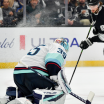Britt, 77, had grown up in Montreal's north end as a good friend of Eddy Palchak, who joined the Canadiens in the late 1960s as an assistant to trainer Larry "Red" Aubut, in time replacing his mentor.
Britt, who had an inventor's curiosity, often was welcomed into the Forum by Palchak. He played in a league with Marc-Andre Beaudin, a plaster sculptor who was developing skill with fiberglass cloth and resins while working for the fledgling goalie mask company founded by Canadiens goaltending legend Jacques Plante.
(Plante popularized the use of the goalie mask in the NHL, wearing one in a game for the first time Nov. 1, 1959, against the New York Rangers at Madison Square Garden
after being badly cut by a shot
. It was a crude but functional mask made for him by Fiberglas Canada salesman Bill Burchmore. Other goalies followed suit by adopting facial protection during the 1960s.)
Beaudin thought Britt's contacts through the airline could prove to be of mutual benefit, so it wasn't long before a barrel of plaster of paris arrived at the latter's home, with Beaudin suggesting that he practice making molds.
"I played with it for a while to figure the consistency, the ratio of material to water," Britt said. "It was a complete ad-lib but I did it with a lot of gusto."
He experimented on his own hands with mixed success, then heard from Palchak that Esposito, brand new with the Black Hawks heading into the 1969-70 season, was coming to Montreal for a preseason game with hopes of getting a new mask. Without ever having molded a goalie's face, Britt lay Esposito down on a table at the Forum, covered his eyes with cotton swabs, inserted straws into the goalie's nose and mouth, slathered petroleum jelly onto his face and troweled on the plaster compound.
"Tony probably figured I worked for Plante's company, not an airline," Britt said with a chuckle. "But Eddy opened doors for me. I told Tony he'd only have to lie still for 20 minutes. There was an ingredient that made the mixture cure, but it got hot on the skin. Well, Tony finally stood up and the mold fell off his face into his hands. It turned out perfectly. They gave me a couple towels, I put the mold in a plastic bag, packed it solidly and sent it to Fibrosport, Plante's company."

























